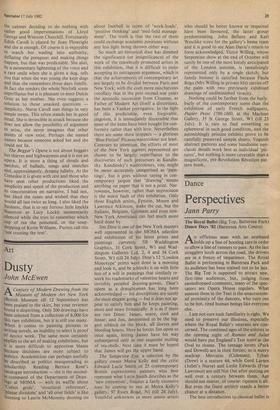Art
Dusty
John McEwen
ACentury of Modern Drawing from the Museum of Modern Art New York (British Museum till 12 September) has been praised to the skies, but your reviewer found it dispiriting. Only 200 drawings have been selected from a collection of 6,000 for this rare exhibition, but it is still too many. When it comes to painting pictures or writing novels, an inability to select is proof of novice work. The same most certainly applies to the art of making exhibitions, but It is more difficult to apportion blame because decisions are more subject to Politics. Academicism can perhaps usefully be described, as politics masquerading as scholarship. Reading Bernice Rose's Catalogue introduction — she is the second- !II-command of the Department of Draw - thgs at MOMA — with its waffle about `Cubist grids', 'structural references', `Planar divisions' and 'all-over fields' is like listening to Laurie McMenemy droning on about football, in terms of `work-loads', `positive thinking' and 'mid -field manage- ment'. The truth is that the two of them could exchange academic positions without any less light being thrown either way.
So much art-historical dust has dimmed the significance (or insignificance) of the work of the ceaselessly promoted artists in this exhibition, that it is difficult to resist accepting its outrageous argument, which is that the achievements of contemporary art are largely to be divided between Paris and New York; with the even more mischievous corollary that in the post-second-war years the apostolic succession from Cezanne, as Father of Modern Art (itself a distortion), has been a Yankee prerogative. In the light of this predictable, even forgivable, jingoism, it is immediately discernible that most of the items have been bought for con- formity rather than with love. Nevertheless there are some show-stoppers — a glorious `Blue Period' Picasso watercolour not least. Contrary to intention, the efforts of most of the New York masters represented are shown to be largely superfluous to the discoveries of such precursors as Kandin- sky. Kandinsky's watercolours, too, might be more accurately categorised as 'pain- tings', but it goes without saying in con- temporary jargon that 'drawing' means anything on paper that is not a print. Nar- rowness, however, rather than imprecision is the worst fault of this exhibition. Only three English artists, Epstein, Moore and Lawrence Atkinson, make the cut, but the Italians, Belgians, Germans and even non- New York Americans can feel much more hard done by.
Jim Dine is one of the New York masters well represented in the MOMA selection and exhibitions of his latest prints and paintings currently fill Waddington Graphics, 31 Cork Street, W I and Wad- dington Galleries Ltd, 2, 4 and 34 Cork Street, WI (till 24 July). Dine's 12 'London Monotype' prints were done in a morning and look it, and he schlocks it on with little less of a will in paintings that similarly re- work his trademarks of valentine hearts and invisibly peopled dressing-gowns. Dine's talent as a draughtsman has long been acknowledged — his descriptions are surely the most elegant going — but it does not ap- pear to satisfy him and he keeps painting, more and more frenetically. It is as if there are two Dines: James, suave, cool and linear; and Jim, determined to be the big- gest schlock on the block, all sleeves and bleeding hearts. Here he forces Jim upon us once again, letting James have his way unhampered only in one exquisite etching of sea-shells. Next time it must be hoped that James will get the upper hand.
The Subjective Eye, a selection by the gallery owner Moira Kelly and the critic Edward Lucie Smith of 25 contemporary British expressionist painters who best represent what Lucie Smith describes as the 'new extremism', finishes a fairly extensive tour by coming to rest at Moira Kelly's gallery, 97 Essex Road, NI (till 24 July). Youthful unknowns or more senior artists
who should be better known or respected have been favoured, the latter group predominating. John Bellany and Karl Weschke score for the gallery's home team and it is good to see Alan Davie's return to form acknowledged. Victor Willing, whose Serpentine show at the end of October will surely be one of the most keenly anticipated of the London autumn, is tantalisingly represented only by a single sketch; but family honour is satisfied because Paula Rego (Mrs Willing in private life) carries off the palm with two previously exhibited drawings of undiminished vivacity.
Nothing could be further from the hurly- burly of the contemporary scene than the exhibition of early French wallpapers, Papier Peint 1780-1860, at the Maclean Gallery, 35 St George Street, WI (till 23 July). It is rare to find something so ephemeral in such good condition, and the astonishingly pristine exhibits prove to be carefully preserved sample sheets. Voguish abstract patterns and some handsome neo- classic details work best as individual 'pic- tures', but nothing is more covetable than a magnificent, pre-Revolution Reveillon pat- tern book.


































 Previous page
Previous page